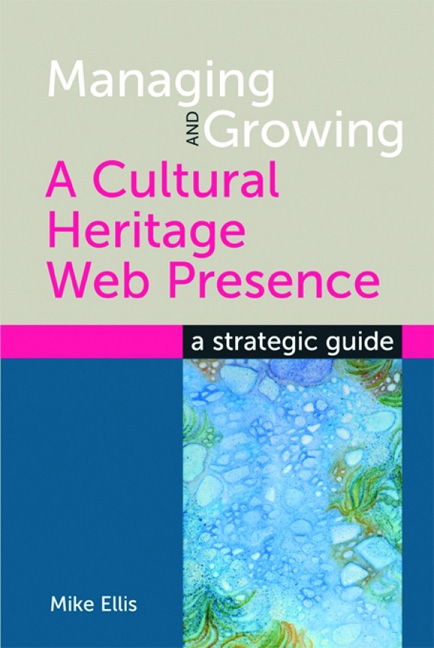Book contents
- Frontmatter
- Dedication
- Contents
- Acknowledgements
- Glossary
- Introduction
- 1 Evaluating what you have now
- 2 Building a strategic approach
- 3 Content
- 4 Marketing
- 5 Policies and guidelines
- 6 Traffic and metrics
- 7 The social web (Web 2.0)
- 8 The website project process
- 9 Away from the browser
- 10 Bringing it all together
- Bibliography
- Index
7 - The social web (Web 2.0)
Published online by Cambridge University Press: 08 June 2018
- Frontmatter
- Dedication
- Contents
- Acknowledgements
- Glossary
- Introduction
- 1 Evaluating what you have now
- 2 Building a strategic approach
- 3 Content
- 4 Marketing
- 5 Policies and guidelines
- 6 Traffic and metrics
- 7 The social web (Web 2.0)
- 8 The website project process
- 9 Away from the browser
- 10 Bringing it all together
- Bibliography
- Index
Summary
Introduction
Over the past few years, the web has been dominated by so-called Web 2.0. The phrase has now been either replaced by the term social mediaor accepted as simply being a core part of the web. The term is closely associated with Tim O'Reilly following an O'Reilly conference called ‘Web 2.0' in 2004, although Wikipedia takes it back to as early as 1999:
The term ‘Web 2.0' was coined in 1999 by Darcy DiNucci. In her article, ‘Fragmented Future,' DiNucci writes:
The Web we know now, which loads into a browser window in essentially static screenfulls, is only an embryo of the Web to come. The first glimmerings of Web 2.0 are beginning to appear, and we are just starting to see how that embryo might develop. The Web will be understood not as screenfulls of text and graphics but as a transport mechanism, the ether through which interactivity happens. It will … appear on your computer screen … on your TV set … your car dashboard … your cell phone … hand-held game machines … maybe even your microwave oven. (http://en.wikipedia.org/wiki/Web_2.0)
Interestingly, many commentators, including Tim Berners-Lee, the ‘inventor’ of the web, have suggested that the phrase is meaningless (Sir Tim called it a ‘piece of jargon’). His reasoning for this – and one shared by a fair number of people – is that what Web 2.0 represents is entirely what the web does anyway, and certainly from Berners-Lee's point of view, exactly what he'd envisaged in the first place.
Furthermore, as with all new approaches, Web 2.0 was at the centre of a fair amount of hype and commercialization during the early part of the noughties. As the hype dies down, Web 2.0 – as with many approaches – becomes more ‘invisible’ as we become used to it, as we saw in our Hype Curve graph in Chapter 1 ‘Evaluating what you have now’.
One of the milestones of the social web was undoubtedly the launch of Facebook, the social networking site. Facebook launched in 2004 but wasn't made available to the public until late 2006. Facebook quickly became a viral success and helped to define and popularize what ‘social’ meant to many people.
- Type
- Chapter
- Information
- Managing and Growing a Cultural Heritage Web PresenceA strategic guide, pp. 117 - 148Publisher: FacetPrint publication year: 2011



